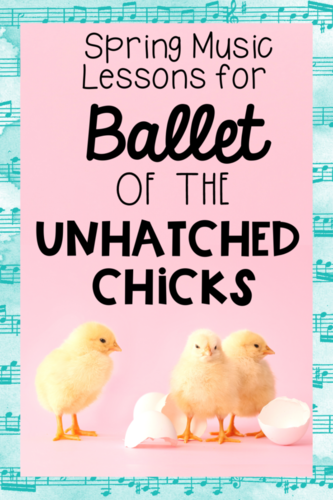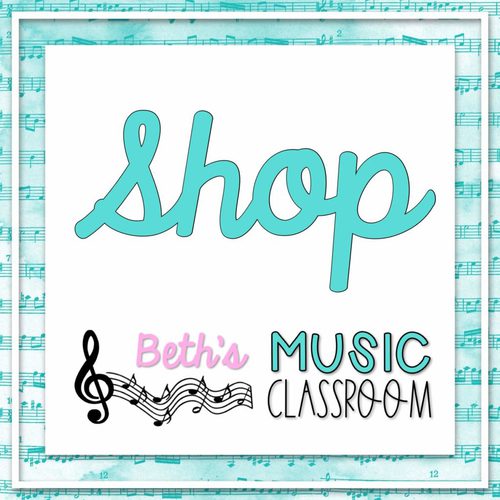Ballet of the Unhatched Chicks

Ballet of the Unhatched Chicks
Each spring, I look forward to using “Ballet of the Unhatched Chicks” by Mussorgsky. It is a popular piece from the composer’s Pictures at an Exhibition. It is an adorable springtime selection that your students will love. Here are some activities that I enjoy using with the “Ballet of the Unhatched Chicks.”
Movement Activities and Dramatic Play

Add Movement Activities and Dramatic Play to the “Ballet of the Unhatched Chicks”
First, with preschool and kindergarten students, I love showing them the painting that inspired Mussorgsky to write this composition. I tell a little story about how the chicks are only partially hatched and are still coming out of their shell. Finally, I just love showing them this video because the chicks have eggshell tutus, helping the students understand the ballet part a little bit more.
After the initial discussion and explanation of the “unhatched” part of “Ballet of the Unhatched Chicks,” Years ago, a retired music teacher shared the lyrics below with me to accompany the piece. This activity is from a book by Deborah Lyn Ziolkoski called “Fun with Composers – Volume 2.” Unfortunately, I believe it’s out of print now.
Let me out. Let me out.
I am feeling icky-sticky. I am feeling icky-sticky.
Let me out. Let me out.
Peck-peck-peck-peck-peck-peck-peck-peck-peck!
These lyrics to the A section are great for helping young students understand the story. I explain that in the first section (A section), the chicks are trying to get out of their eggshells, pecking and shaking to be free – non-locomotor movement. Students curl up like they are in an eggshell, and act out the text.
Finally, they are free during the B section. I tell students to explore the area now that they are out of their shell. Now students are practicing different locomotor motions – dancing, skipping, walking, tip-toeing, etc. Scarves also work well with this activity.
As the piece ends with the A section again, I tell students to think back when they were in their shells and chant the text again with the music. Students recognize the differences between the two sections, and we discuss it together at the end.
Body Percussion

Add Body Percussion to the “Ballet of the Unhatched Chicks”
Also, I love using body percussion with the “Ballet of the Unhatched Chicks.” This works well with first and second grade classes. Sometimes I will have students work together to create their own 4 or 8 beat body percussion pattern to accompany the piece. Then we practice each one and pull different parts from each to create our class routine.
This year with distance and hybrid learning, I am using a body percussion routine video with my first graders. It displays each motion along with the song. Students will practice using the video at home, record themselves, and then we will piece parts together to create a performance video for parents and teachers.
Rhythmic Instrument Activities
Finally, with second and third graders, I use “Ballet of the Unhatched Chicks” along with rhythm instruments. Using classroom percussion instruments, each student is assigned a part to play. They read their rhythmic ostinato and perform it to accompany the music. My second graders sometimes remember dancing to the song in kindergarten, and they get excited to do it the “big-kid way” now.
For a simplified rhythmic activity, use two types of rhythmic instruments – one for each of the two sections. Students can either play a steady beat or an assigned rhythm pattern during their section. For a slightly more advanced activity, use a few rhythmic ostinatos for each section. I use this arrangement often with second and third graders.
As spring and Easter approaches, I hope you and your students enjoy these activities for the “Ballet of the Unhatched Chicks.”
If you’re looking for some more fun lessons on classical music and compositions, click here for some more ideas on how to use them in your classroom successfully.




Hi! This activity/lyrics is from Fun with Composers by Deborah Lyn Ziolkoski. It’s from a paid resource and although I don’t believe it is available for purchase anymore, it would still be good to have it credited!
Oh, thank you so much for letting me know the source of this activity! It’s such a cute activity too. I updated the information in the post above. Thanks again, Meaghan!